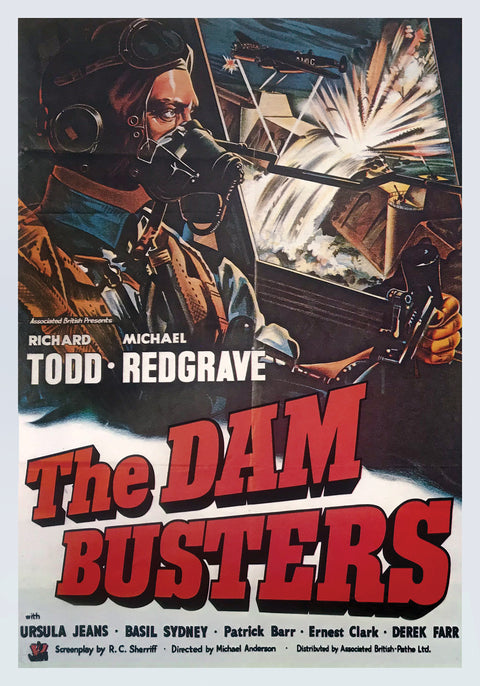
‘The Dam Busters’ Tells a Timeless Story But Hasn’t Aged Well
The “dam busters” mission has gone down in history as a legendary feat by the Royal Air Force. On the night of May 16, 1943, 19 Avro Lancasters of the recently created 617 Squadron took off from their base at RAF Scampton. Their mission: to breach three dams in Germany’s Ruhr Valley and deal a major blow to the enemy’s industrial capability. Led by Wing Commander Guy Gibson, the airplanes of Operation Chastise carried a specially designed “bouncing bomb” developed by inventor Barnes Wallis. The dam busters managed to breach two of the dams, but at great cost. Eight Lancasters were lost, and 53 airmen were killed and three captured. The Germans were able to repair the damage relatively quickly. Despite the losses and the Germans’ quick recovery, the feat captured the British imagination as an example of the bravery and innovation that was needed to win the war.
The Dam Busters , the 1955 film about the mission, is based on the 1951 book of the same name by Paul Brickhill and Gibson’s own account, Enemy Coast Ahead (published posthumously in 1946). The movie opens as Wallis (Michael Redgrave) experiments at his home trying to bounce marbles across the water in a tin basin. It’s part of his scheme to design a bomb that can destroy German dams. Conventional weapons don’t work because the water dissipates the force of their explosions. Wallis theorizes that a bomb skipping across the surface would hit a dam and sink before exploding at the base, where the water pressure behind it would amplify the explosion’s effect. Officials are skeptical, and their doubts only increase following failure after failure. Finally, Wallis achieves success, and the mission moves forward.
Playing Gibson, who had a reputation for not suffering fools gladly, is actor Richard Todd, a World War II veteran himself. Gibson finds that the mission will be no piece of cake. The four-engine Lancasters will have to go in very low—60 feet above the water on their final approaches—and the bomb drops need to be precise. The film embraces one dam busters legend by asserting that Gibson got the idea of how to determine proper altitude when he noticed the spotlights at a theatrical performance. He is inspired to mount two downward pointing spotlights on each bomber, adjusted so the beams will converge on the water at 60 feet. To determine range, the bombardiers use a simple wooden hand-held sight.
Director Michael Anderson opted to shoot the film in black and white to give it a grittier, documentary feel. It also allowed him to incorporate actual footage from the bomb testing, but with one drawback: aspects of the weapon remained classified at the time, so the filmmakers had to paint over the test footage frame by frame to hide the bombs’ shapes and the fact that they spun backwards (which allowed them to “crawl” down the side of the dams before exploding). The end result may have preserved secrecy, but the alterations are obvious.
Richard Todd played Wing
Commander Guy Gibson in The Dam Busters. As a paratrooper, Todd had parachuted
into Normandy on D-Day. Behind him is one of the four Avro Lancasters that the
filmmakers wrangled for the picture.
The special effects in general have not aged well. Ground fire is clearly an animated effect and some of the model work doesn’t stand up to scrutiny. The filmmakers might have been aware of this. The first aerial shot of one of the dams is clearly a model, but then the camera pans back to show that it is , in fact, a model, one constructed for the aviators’ training. What remains timeless are the sequences of the Lancasters. The production was able to procure four of them for the shoot—only 10 years after the war’s end the bombers were already in short supply—and the sight and sound of these mighty Merlin-powered beasts roaring by at low altitude will please aviation aficionados. The attack sequences remain exciting, models notwithstanding.
Those battle scenes inspired George Lucas when he was creating the final attack on the Death Star in 1977’s Star Wars , and a comparison of the two films will show some startling similarities and even some shared dialogue. (They also shared the talent of Gilbert Taylor, who did special effects photography on Dam Busters and was the cinematographer for Star Wars.) The attacks are not the only thing that might have inspired Star Wars. The hairstyle worn by Wallis’s movie wife (Ursula Jeans) has more than a passing similarity to the “cinnamon buns” sported by Carrie Fisher’s Princess Leia in Lucas’s movie.
The special effects, however, are not the only thing about The Dam Busters that has aged badly. There’s also the matter of Gibson’s dog, whose name is a racial slur that would have been, at the very least, offensive in 1955 and has since become completely unacceptable, and it’s a word that is woven throughout the movie (the dog’s name provides one of the code words the busters use to signal a dam breach). American distributors considered overdubbing to change the name to “Blackie,” but did not. Although the dog’s name is historically correct, modern audiences will find it jarring, or may think they stumbled into a bit of pointed Blazing Saddles -style social satire by mistake. No doubt this aspect of the film is the reason why The Dam Busters is impossible to find on any streaming services; a 2021 Blu-ray release, though, offers a restored print of the film and plenty of extras.
